A Private Tour today in North Norfolk. A different type of tour today, it was to be a whistlestop journey along the coast, from east to west, trying to pick up as many interesting birds as we could in the time available. The weather was not particularly amenable, with some light drizzle through the morning and then thickening cloud in the afternoon after a brief spell of blue sky around the middle of the day. Thankfully, it didn’t start to rain again until just after we had finished and we were on our way back.
Our first destination was Cromer. There has been a juvenile Iceland Gull on the golf course here for several days. We parked and walked back along the pavement, scanning the grass and it didn’t take long to find it, walking around on one of the fairways not far from the side of the road.
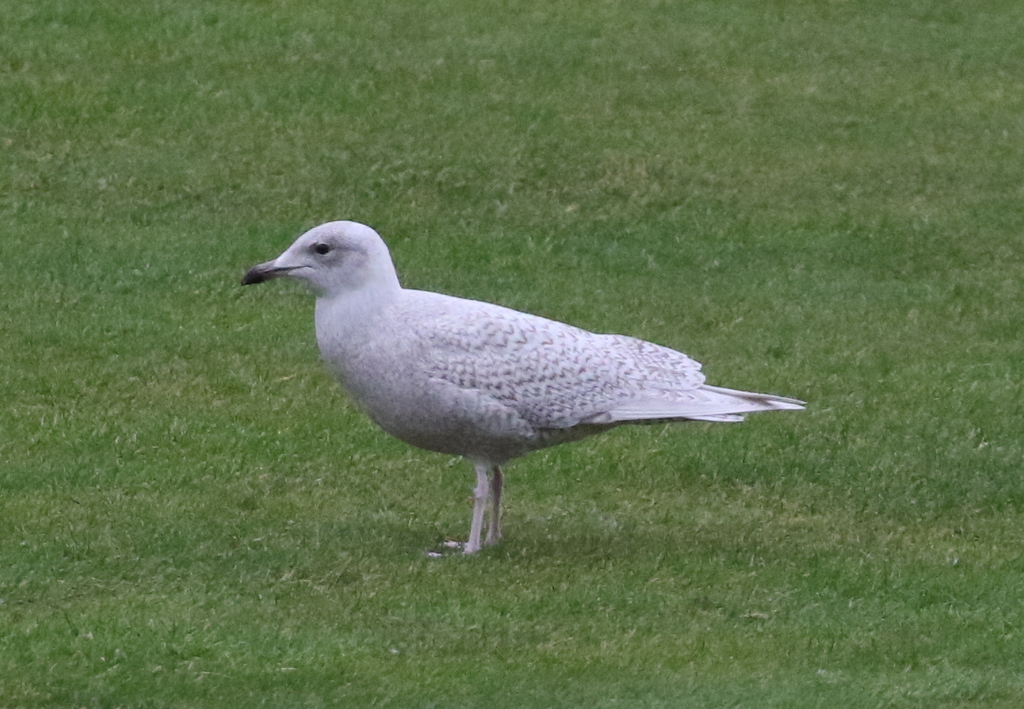 Iceland Gull – showing very well on the fairway at Cromer Golf Course!
Iceland Gull – showing very well on the fairway at Cromer Golf Course!
We had a good look at the Iceland Gull. We could see it was a rather delicate large gull with longish wings, pale biscuit colour overall, with paler wingtips. The eye was dark and the bill mostly so, with a hint of a paler base developing, confirming it as a juvenile.
Further along the edge of the road, we met a couple of people looking for some Redpolls which had been seen going into a weedy area by the edge of the golf course. When one of the greenkeepers drove past, they flew up and looked as if they might land in a large hawthorn bush. Unfortunately instead they disappeared round behind it. We waited a while to see if they might reappear, but after the greenkeepers had driven past a couple more times and nothing had come out we figured they must have gone somewhere else. With a busy schedule for the day, we headed off.
Our next stop was at Salthouse. We were hoping to see the flock of Snow Buntings here, but they have been very mobile, roaming up and down several miles of the shingle ridge, right up to the end of Blakeney Point, so we needed a bit of luck. Unfortunately, our luck was out – there was no sign of them in any of the places they have been favouring. It was not particularly pleasant standing up on the shingle in the drizzle, so we decided to carry on our way west rather than wait to see if they would reappear.
We did add a few other birds to the day’s list while we were at Salthouse. Scanning offshore, we picked up a couple of Guillemots out on the sea and a couple of Red-throated Divers flew past. A Skylark and a Meadow Pipit were feeding around one the small pools on the edge of the grazing marsh. A few Wigeon were scattered about the grass too and a drake Shoveler was on one of the pools below the shingle ridge. Several skeins of Pink-footed Geese flew overhead calling.
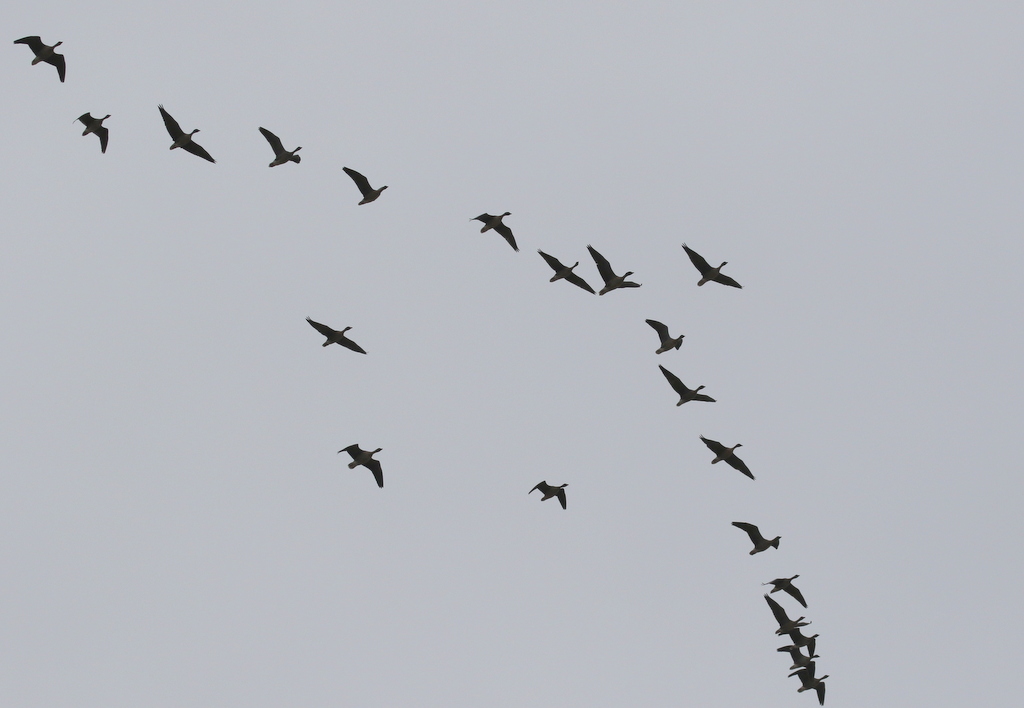 Pink-footed Geese – several skeins flew over us at Salthouse
Pink-footed Geese – several skeins flew over us at Salthouse
After negotiating our way round an unscheduled road closure, we managed to get onto Lady Anne’s Drive at Holkham. A small covey of Grey Partridge were on the grass not far from the side of the drive. An Egyptian Goose flew past, flashing its bold white wing patches.
The Shorelarks out on the saltmarsh here had not been reported yesterday, but we thought it was worth a quick look anyway. As we walked through the pines, a birder coming back the other way told us there was no sign of them. We went out to look for ourselves anyway, but the best we could manage was a large flock of around 30 Skylarks. There was quite a lot of water on the saltmarsh today. It was still drizzling steadily, so we headed back to Lady Anne’s Drive.
As we walked back towards the car, a small group of Bullfinches flew up from the brambles beside the ditch and landed a little further along – we could see a couple of smart pink males and at least one female. A flock of about 100 Brent Geese had appeared on the grazing marsh by the car park while we were out on the saltmarsh. A quick look through them revealed that one was slightly darker than the others, with a slightly brighter white flank patch. It was the regular Black Brant hybrid which is often with the Dark-bellied Brent Geese here.
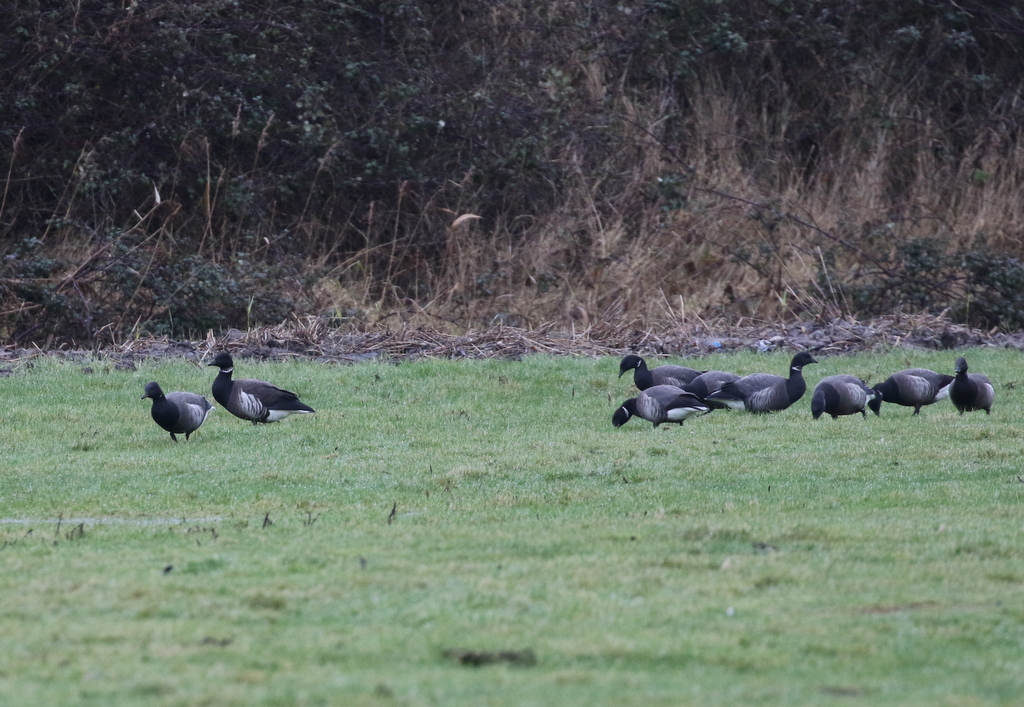 Black Brant hybrid – second from left, with the Dark-bellied Brents
Black Brant hybrid – second from left, with the Dark-bellied Brents
There were lots of Pink-footed Geese calling noisily, flying over and landing in the fields. We could see a few Marsh Harriers out over the grass and a Common Buzzard or two perched in the trees or flying round. As we drove back up Lady Anne’s Drive towards the main road, a Stonechat perched on the fence and kept dropping down to the ground to look for food.
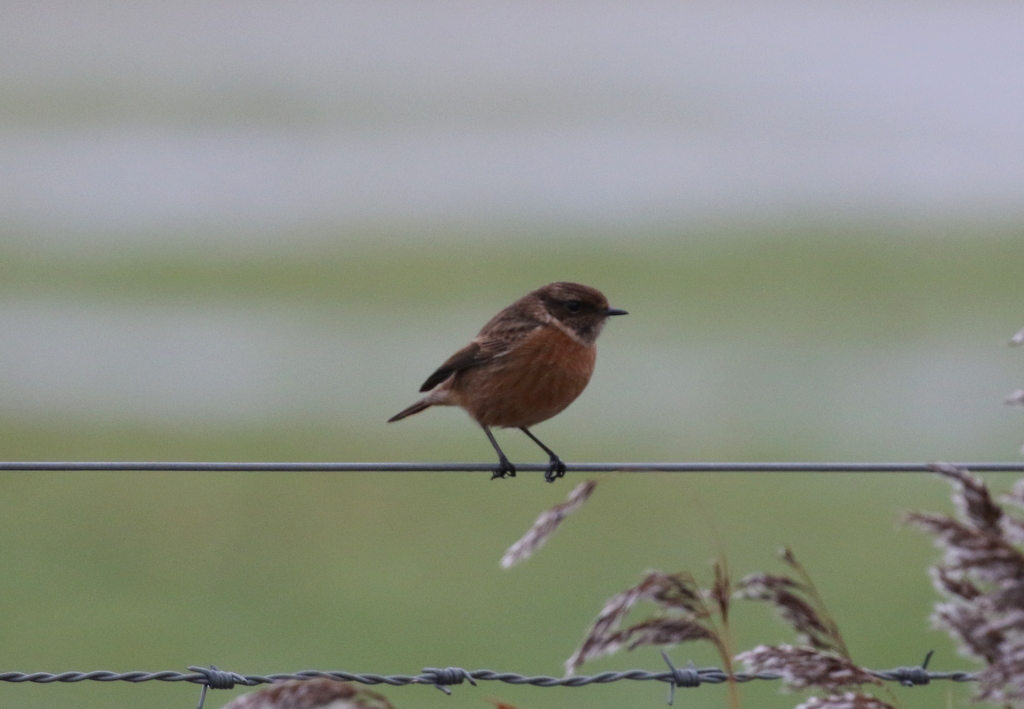 Stonechat – feeding from the fence beside Lady Anne’s Drive
Stonechat – feeding from the fence beside Lady Anne’s Drive
A little further on and we stopped again to look at the grazing marshes. There was quite a bit of water on there today, after all the recent rain, and at first there didn’t seem to be much in the way of birdlife. But then we spotted a Great White Egret flying in from the east and it dropped down by the edge of one of the ditches. Even before it landed, we could see just how big it was and when it touched down we could see its long yellow bill.
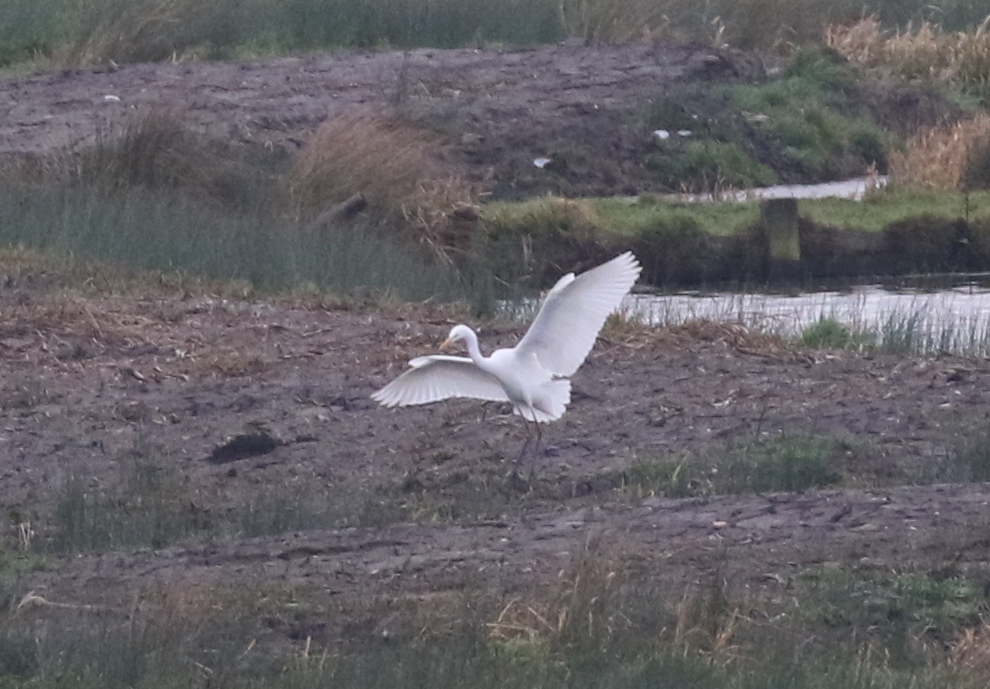 Great White Egret – flew in and landed out on the grazing marsh
Great White Egret – flew in and landed out on the grazing marsh
This is often a good place to see geese, but there didn’t seem to be too many out here today. There were a few Greylags, but more of them seemed to be in the fields by the road today. A careful scan eventually brought its reward – first a little group of Pink-footed Geese and then, just beside them, a pair of White-fronted Geese, the one we were really looking for here. We could see their distinctive dark belly stripes and, when they raised their heads, the white surround to their bills.
Looking out to the west, we also spotted a single Red Kite circling out over the grazing marshes. Then it was time to carry on our way west. We got as far as Titchwell on the coast road and turned in land. As we headed up the road towards Choseley, a couple of Red-legged Partridges were in the fields, but the area around the drying barns was very busy and there were no birds here today.
It was starting to brighten up nicely now. Continuing on inland, we came across a huge flock of finches in the hedge beside the road. We stopped the car and got out for a closer look – there were lots of Chaffinches, Goldfinches and Linnets. A couple of Greenfinches perched unobtrusively in the bushes. Looking carefully threw the throng, we eventually found a couple of Bramblings with them too.
A little further on, we spotted several Yellowhammers dropping down into the middle a field. They had disappeared out of view, so we decided to have another look here on our way back. The last field we checked seemed to have many more birds – there were lots of Reed Buntings and Yellowhammers in the hedge which kept dropping down into the cover strip below. We could hear Tree Sparrows calling and it wasn’t long before one appeared in the hedge too.
As we got back into the car, an approaching tractor driving down the road flushed a Sparrowhawk from the hedge and it flew straight towards us and landed in the trees right next to us. Needless to say, as we opened the window and raised the camera, it was off! We were on a roll now, and back to the first field where we had seen the Yellowhammers land earlier and we arrived just in time to see several birds fly up out of the crop. Two larger birds flew across and landed in the top of the hedge on the far side – two Corn Buntings, the bird we had hoped to see here. While we were watching the Corn Buntings in the scope, we spotted a couple of Stock Doves flying over too.
 Black-tailed Godwit – feeding in Thornham Harbour
Black-tailed Godwit – feeding in Thornham Harbour
It had clouded over again when we arrived in the car park at Thornham Harbour. We met one of the local wildlife photographers just packing up to leave and he told us he had just been watching the Twite on the edge of the saltmarsh immediately beyond the car park so we hurried straight over. We couldn’t see them at first as they were hiding down in the vegetation on the other side of the channel. There were a couple of Redshank and a single Black-tailed Godwit out on the mud.
We were just scanning for the Twite when they flew up out of the vegetation and straight towards us. They circled over and landed down by the puddles in the car park just behind us. We had a great look at them as they drank, there were about 20 of them in total. We could see their orange faces and yellow bills. They didn’t stay there too long though and the next thing we knew they were off again, out across the saltmarsh.
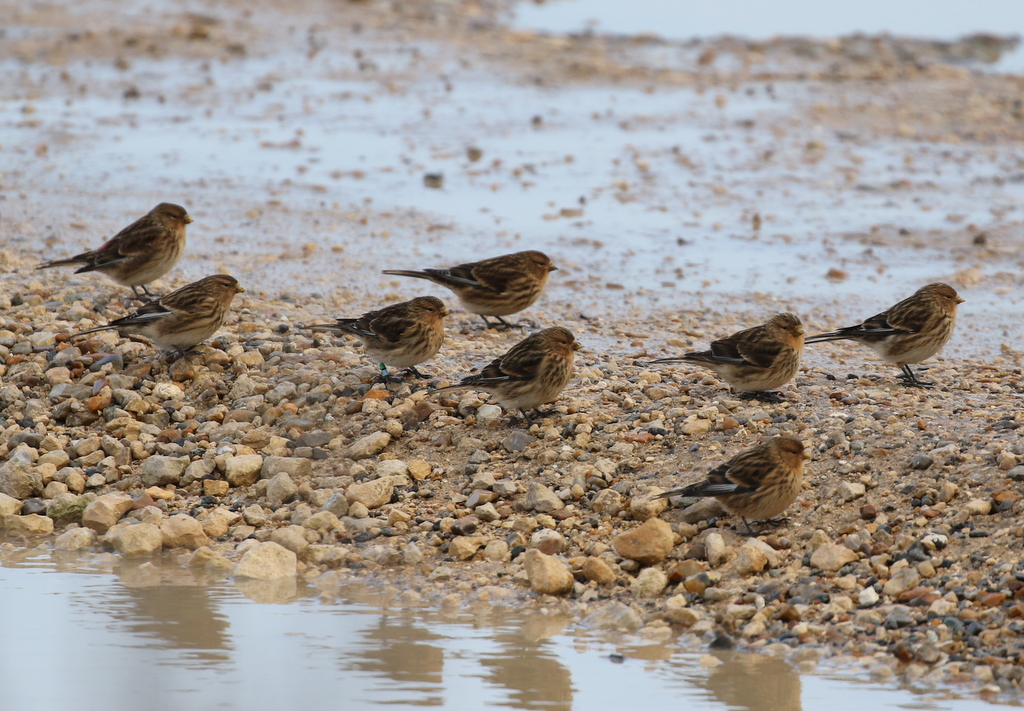 Twite – came down to the puddles in the car park to drink
Twite – came down to the puddles in the car park to drink
After the Twite had flown off, a Rock Pipit flew past us and landed on a post just in front of us. They are fairly common winter visitors to the saltmarshes along the coast, Scandinavian Rock Pipits rather than our British ones which favour rocky coasts.
 Rock Pipit – landed on a post just in front of us
Rock Pipit – landed on a post just in front of us
Having seen the Twite, our main target here, so quickly we made our way straight round to Titchwell next. After a quick bite to eat, we headed out to explore the reserve.
The main birds we wanted to see here today were out at the sea, so with the wind starting to pick up a bit, we made our way fairly quickly in that direction. A quick look in the ditches by the path failed to produce the hoped for Water Rail. Thornham grazing marsh and the reedbed pool looked rather quiet, although a Cetti’s Warbler shouted to us from deep in the reeds. A single Common Snipe was out on Lavendar Marsh, along with lots of Lapwing.
The water level on the freshmarsh is very high now and there are not many places for waders here. The tiny remnant of the island by the junction to Parrinder Hide had about twenty Ruff huddled round it, along with 5 Avocet which have decided to try to slug it out here rather than head south for the winter. There were a few more Lapwing too. Further out, the top of Avocet Island still protruded from the water and was fairly covered in Golden Plovers.
There were lots of duck out on the freshmarsh, enjoying all the water. As well as the usual Teal, Wigeon and Mallard, Gadwall was a welcome addition to the day’s list here. It was really nice to see quite a few Pintail too, including several very smart drakes. There was a raft of diving ducks around the taller island over towards the back – several Common Pochard and a couple of Tufted Ducks – but we couldn’t see the Red-crested Pochard which had been reported earlier. A big flock of Brent Geese flew in from the saltmarsh out towards Brancaster and landed out on the water to bathe & preen.
There were more waders on the mud on Volunteer Marsh. From the main path, we could see several Ringed Plover and a Grey Plover, as well as a number of Redshanks and a Curlew or two. There were more waders down along the muddy channel which runs away beside the bank at the far end, including several Black-tailed Godwits, but no sign of the Spotted Redshank that had been reported here earlier. With the tide out now, it could easily have been hiding in the bottom of the channel somewhere.
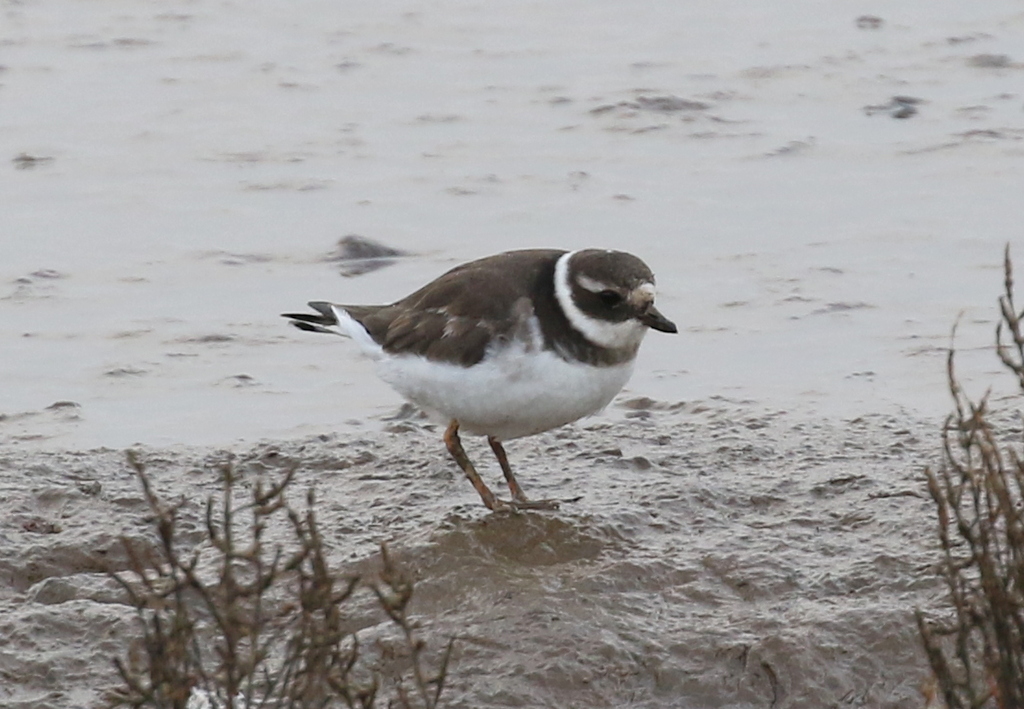 Ringed Plover – one of several on the Volunteer Marsh
Ringed Plover – one of several on the Volunteer Marsh
A single Dunlin with all the Black-tailed Godwits roosting on the Tidal Pools was the only bird of note, but we didn’t really stop to look here. Then it was on to the beach. We got ourselves into the shelter of the dunes and started to scan. There was an excellent variety of birds out here today.
Just about the first birds we found out on the sea were the Long-tailed Ducks. There were about 12 of them, diving just offshore, including some very smart long-tailed drakes. Also just offshore, we could see a few Common Scoter and Goldeneye. We picked up a drake Red-breasted Merganser on the sea too, before a group of about eight more flew in. A single female Eider rounded off the great selection of seaduck.
There had been a Great Northern Diver off here earlier, but that took a little longer to find, mainly because it was diving constantly. Eventually we got that in the scope too. A distant Great Crested Grebe was another addition to the list. While we were looking at all the birds on the sea, we kept one eye on what was flying past. A small gull, flashing alternately pale silvery grey/white upperparts and black underwings was an adult Little Gull, closely followed by two more. Several have been lingering offshore here in recent days.
There were lots of waders out on the beach too. Scanning through them carefully produced several Bar-tailed Godwit, Knot, Grey Plovers, Turnstone and Oystercatchers. Unusually, a single Sanderling took a bit of finding amongst all the Dunlin out on the sand today.
Having done so well out on the beach, we started to make our way back at a more leisurely pace. Scanning carefully around the Tidal Pools, we finally located two Spotted Redshanks. They were asleep, tucked down behind one of the islands, but one woke up long enough to flash its long, needle fine bill and more prominent pale supercilium than the regular Common Redshanks.
We stopped in at Parrinder Hide on the way back. There was still no sign of the Red-crested Pochard, nor any Water Pipit around the remnants of the islands, but there was a single Goldeneye diving out on the water. The Golden Plover were very nervous, flying up continually, whirling round calling plaintively, before landing down again.
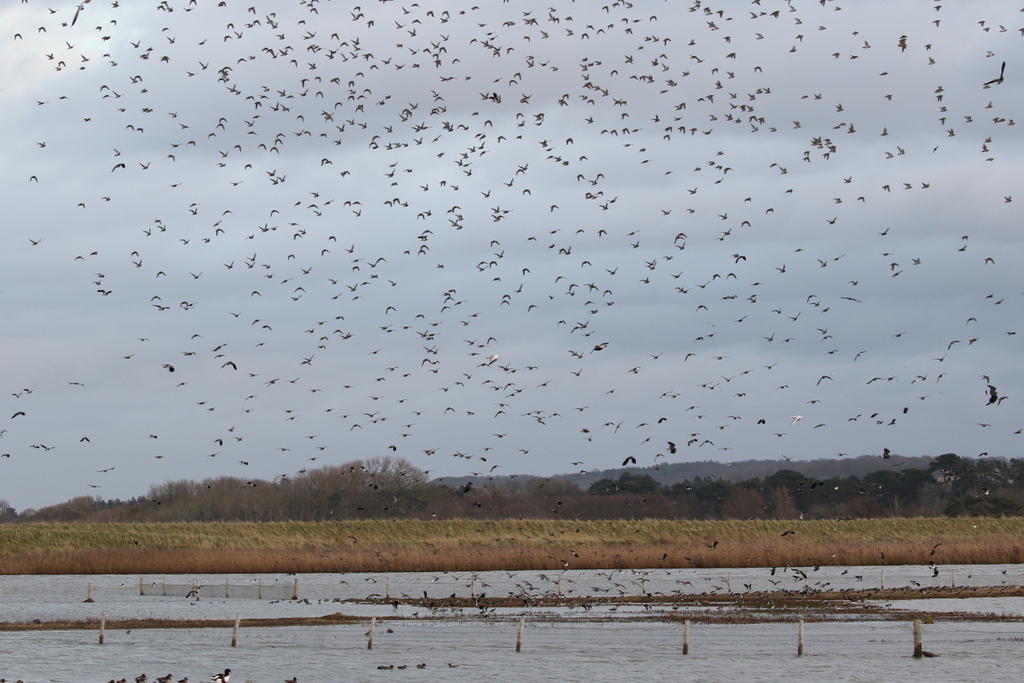 Golden Plover – periodically whirling round nervously over the freshmarsh
Golden Plover – periodically whirling round nervously over the freshmarsh
It was starting to get dark now, so we continued on our way back towards the car. We stopped briefly by the reedbed where the Marsh Harriers were gathering to roost. We counted 18 all in the air together at one point. Then it was time to head for home.
We had missed a few birds today – not a surprise given the weather and the fact that we didn’t have time to stop and wait for things to appear – but even so we had managed to see some very good ones. And, when we added up the total at the end of the day we had amassed a very respectable 97 species (96 seen, and the Cetti’s Warbler which we had just heard). A good way to start the year!
















